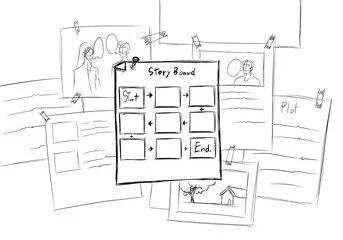How Graphic Organizers Improve Reading Skills Through Visual Magic
Let’s face it - with so many thoughts, words, ideas, storylines, characters, and more, reading can become challenging and frustrating for some.
Now imagine you had a guide to help you navigate the written worlds that exist inside books. This guide can help you understand the storyline, connect with the characters, understand the content, and much more. This is exactly what graphic organizers can do for students! Students who face reading challenges can learn to despise reading. Graphic organizers can bring the magic back into reading—and can even create a newfound love for books.
Here is everything you need to know about graphic organizers and how they help improve reading skills:
What is a Graphic Organizer?
A graphic organizer is a visual representation of content. In other words, it is a snapshot that depicts information. This cohesive chart or diagram assists students with a breakdown of the following information:
Organizing text
Sets of instructions
Storylines
Connect ideas
Comprehend what they are reading
And more
Graphic organizers can be created in a variety of shapes, sizes, and design styles. The most popular include the following:
Story maps – Help students outline key concepts of a story such as plot, setting, characters, conflict, storyline, and resolution
Venn Diagram – Perfect for comparison and contrasting between two or more notions, ideas, or characters
Flowcharts – Great for depicting the sequence of events within a story or different instructional steps in a process
KWL charts – Helps students track what they already know, what they aim to learn, and what they have already learned thus far
Main idea and details chart – Assists students with breaking down the main idea of a passage by supporting it with key details
Graphic organizers are versatile and offer creative outlets for students. These guides are a fun and exciting way for students to break down complex topics and comprehend what they are reading in a more efficient way. They can be adapted to any grade level, subject, or topic, making them a useful tool that assists students with reading difficulties.
How Graphic Organizers Tackle Reading Challenges
Graphic organizers are magical creations that can help with a variety of different reading materials and their respective challenges. They are a proven method to help kids who struggle with reading and material comprehension.
Here is how graphic organizers help students with reading challenges:
Improving comprehension
One of the biggest hurdles for students with reading challenges is understanding what they’ve read. Maybe the text is too dense, or the student struggles to pick out the main idea. A graphic organizer helps by visually breaking down the text into bite-sized pieces.
For example: Story maps help students focus on the key components of a story or material—the who, what, where, when, why, and how of the content. The students can focus on each element at a time versus not knowing what to do with the information. This mental image assists with their comprehension.
Organizing thoughts and information
Let’s be honest—keeping track of all the details in a book or article can be hard! But for students with learning disabilities like ADHD or dyslexia, it can feel almost impossible. That’s where a graphic organizer comes in handy.
When students see these sequences and create a timeline, they can visualize how one event leads to another. Actually “seeing” the story in this method versus staring at thousands of words on a page with no meaning.
Boosting retention
Graphic organizers can help with retention and memory. When ideas are too abstract, students may become frustrated with the lack of a concrete visual in their minds. These organizers help draw connections between the storyline, characters, main ideas, supporting elements, and the main message of the content itself.
By breaking it down in this manner, students have a better chance of memory recall later. The main idea and details chart is a great way to help students visually “see” the big picture as they navigate the smaller, supporting elements of the text.
Encourage active reading
Students who struggle with reading may not have an interest in reading at all. Graphic organizers can help turn that around! They are the perfect tool to keep students’ minds focused and alert. A KWL chart is one of the best ways to accomplish this.
Students will be directed to write down what they know about the topic. Next, they will jot down what they want to know and learn, and what they have learned after finishing the reading. This engages the students to participate before, during, and after reading is done. This creates an interactive approach that excites the student versus creating frustration.
Making vocabulary more exciting
Words can feel scary to students who struggle with reading. Using a word map graphic organizer helps students unpack the meaning of the words and vocabulary they learn. This may include synonyms, antonyms, definitions, and using the vocab word in a sentence.
By usual visual breakdowns of the word’s meanings, students gain confidence in learning new words. They will be increasingly motivated to continue their reading comprehension journey as it becomes easier with these graphic organizers.
Fun Ways to Use Graphic Organizers
The term “graphic organizer” does not sound that appealing. However, they can be fun, enjoyable tools that stimulate interest in reading and books.
Here are the top fun ways to use graphic organizers:
Color coding – Inspires students to utilize different colors per section of the graphic organizer. For example, red can be used for character, blue for plot, red for conflict, and more.
Digital versions – If your student enjoys technology, online apps, and tools offer interactive graphic organizers. A variety of options are available that can aid students in filling out maps, diagrams, and charts right on their own phones or a computer. This can be wildly more appealing for new-age students.
Group work – Graphic organizers can be utilized in a collaborative approach. Students can conduct group work and work together to complete an activity. They can bounce ideas off one another, thus furthering their comprehension and understanding. This can also help with socialization and making reading fun!
Personalization – When things are personalized, they are instantly more fun. By allowing students to create their own graphic organizers based on their interests, motivation, participation, and interest increases. They take ownership of their learning process, which can boost self-esteem and confidence—and the interest in reading altogether!
Success Story
Breanna was a sweet 4th grader who loved stories. However, she struggled with keeping track of all the details when she was reading. When the teacher would ask questions about the key events or main ideas of the story, Breanna would panic.
Breanna felt frustration and embarrassment by not being able to comprehend or retain the information she was reading. She no longer liked reading and did not want to participate in class. This all changed when her teacher recognized the signs and took immediate action.
The teacher used a graphic organizer to help with Breanna’s reading struggles. She used the story map, which helped break down the complex ideas, setting, plot, characters, and major events in the story. Breana could now visualize all these elements, and suddenly, everything clicked!
Within a short time frame, Breanna flourished in reading comprehension. She fell in love with stories again and even started raising her hand in class. Breanna’s reading comprehension scores also improved on tests. She became a fanatic of books and reading, showcasing that all she needed was a little visual structure assistance to truly shine.
Bottom Line
Graphic organizers are useful tools that help students navigate the sometimes complex world of reading. They help combat reading challenges by creating visual charts that are both fun and appealing.
The best part? Graphic organizers are flexible, fun, and can be used across all subjects—whether it’s breaking down the plot of a novel, organizing facts for a science project, or even comparing historical events in social studies. So next time your child faces a reading challenge, consider pulling out a graphic organizer and watch as the words fall into place!
The Mind Center, LLC is a thought leadership mental health brand dedicated to helping parents, their kids, and the schools they attend. At the heart of what we do, we have your little one's best interest in mind. We help kids thrive, by providing school-based testing services that put your mind at ease, and make their educational wins something you and your child can be proud of. Be sure to check out the testing and support services that we offer by clicking here. To learn more about the services, book a call today! Click here







